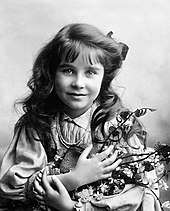Grosvenor Gardens House
Grosvenor Gardens House is a Grade II-listed mansion block at 23–47 Grosvenor Gardens, Belgravia, London. Queen Elizabeth The Queen Mother may have been born there in 1900. David Niven was born there in 1910, and William Henry Blackmore killed himself there in 1878. As of March 2017, the building is the subject of a £132-million High Court trial for damages brought against Christian and Nick Candy.
.jpg)

History
Grosvenor Gardens House was built in about 1868 by the architect Thomas Cundy III in the French Renaissance style.[1] It was originally called Belgrave Mansions, and when it was finished in 1868, it was London's first serviced apartment block.[2] It was converted into a hotel in the 1920s, and then into offices in the 1930s.[2]
In 1878, William Henry Blackmore (1827–1878), killed himself in his study at Belgrave Mansions.[3]
In 2011, the 125,000-square-foot (11,600 m2) full street block was purchased by Oakvest, and in 2013 Westminster City Council granted planning permission for conversion into 42 luxury flats, subject to a £7.1 million financial contribution to the Council's affordable housing fund.[2]
Notable residents

Queen Elizabeth The Queen Mother's 1900 birthplace remains uncertain, and Belgrave Mansions is one of the leading contenders, in a flat rented by her paternal grandparents and which her parents Lord Glamis and Lady Glamis stayed in when in London.[4][5]
Notable residents have included the actor David Niven, who was born there in 1910.[6]
Lieutenant General Sir Lewis Pelly (1825–1892), the army officer and member of Parliament, lived there.[7]
Court case
As of March 2017, the building is at the centre of a £132-million High Court trial for damages brought against Christian and Nick Candy by the entrepreneur Mark Holyoake.[8]
References
- Historic England, "23–47 Grosvenor Gardens (1288701)", National Heritage List for England, retrieved 19 March 2017
- "Westminster approves Grosvenor Gardens House plans". Out-law.com. Retrieved 19 March 2017.
- Petch, Alison. "Pitt-Rivers and Blackmore". Web.prm.ox.ac.uk. Retrieved 19 March 2017.
- Weir, Alison (1996), Britain's Royal Families: The Complete Genealogy, Revised edition, London: Pimlico, p. 330, ISBN 0-7126-7448-9
- William Shawcross (2009). Queen Elizabeth: The Queen Mother : the Official Biography. Macmillan. pp. 15–16. ISBN 978-1-4050-4859-0.
- Morley, Sheridan (1997). David Niven, Brief Lives. Oxford: Oxford University Press. p. 413. ISBN 0198600879.
- "Letter from Lewis Pelly, Belgrave Mansions, Grosvenor Gardens to Lord Elcho [13r] (9/30) | Qatar Digital Library". Qdl.qa. 9 March 2017. Retrieved 19 March 2017.
- Garside, Juliette (18 March 2017). "'Brothers bling': lawsuit puts Nick and Christian Candy in spotlight". The Guardian. Retrieved 19 March 2017.
External links
